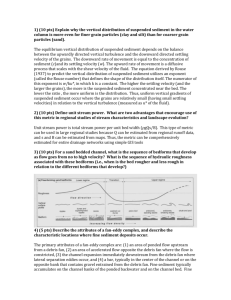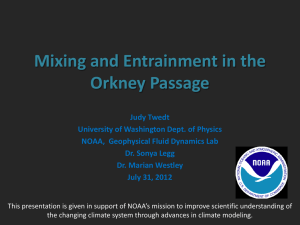The Effect Of Gas Velocity On The Entrainment Process
advertisement
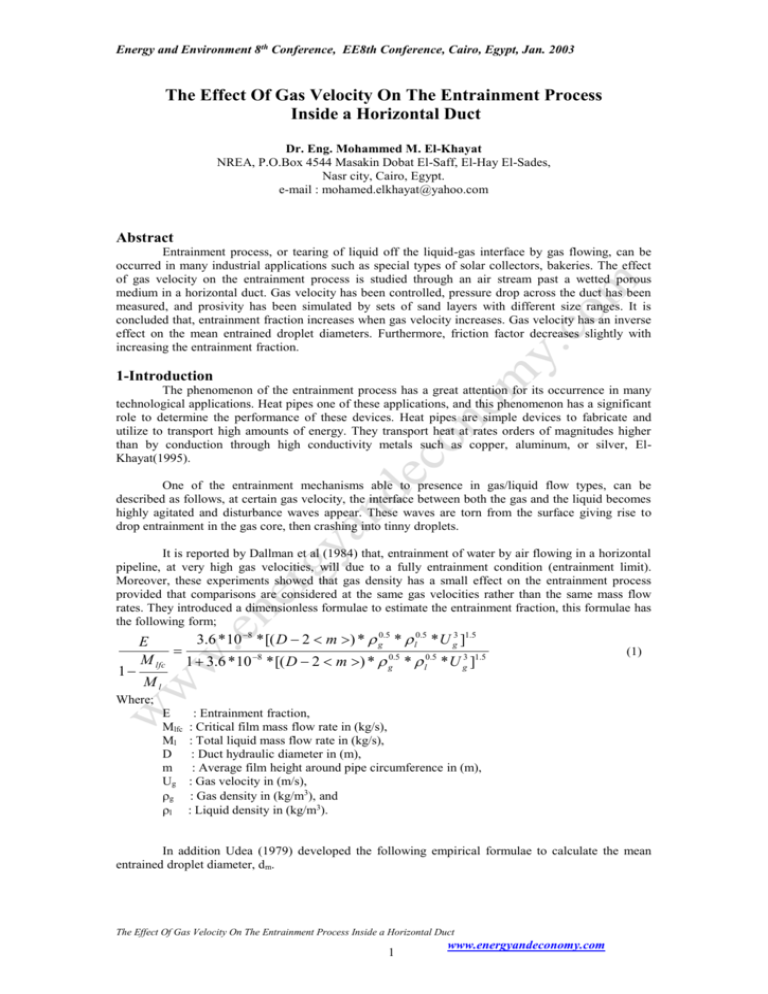
Energy and Environment 8th Conference, EE8th Conference, Cairo, Egypt, Jan. 2003 The Effect Of Gas Velocity On The Entrainment Process Inside a Horizontal Duct Dr. Eng. Mohammed M. El-Khayat NREA, P.O.Box 4544 Masakin Dobat El-Saff, El-Hay El-Sades, Nasr city, Cairo, Egypt. e-mail : mohamed.elkhayat@yahoo.com Abstract Entrainment process, or tearing of liquid off the liquid-gas interface by gas flowing, can be occurred in many industrial applications such as special types of solar collectors, bakeries. The effect of gas velocity on the entrainment process is studied through an air stream past a wetted porous medium in a horizontal duct. Gas velocity has been controlled, pressure drop across the duct has been measured, and prosivity has been simulated by sets of sand layers with different size ranges. It is concluded that, entrainment fraction increases when gas velocity increases. Gas velocity has an inverse effect on the mean entrained droplet diameters. Furthermore, friction factor decreases slightly with increasing the entrainment fraction. 1-Introduction The phenomenon of the entrainment process has a great attention for its occurrence in many technological applications. Heat pipes one of these applications, and this phenomenon has a significant role to determine the performance of these devices. Heat pipes are simple devices to fabricate and utilize to transport high amounts of energy. They transport heat at rates orders of magnitudes higher than by conduction through high conductivity metals such as copper, aluminum, or silver, ElKhayat(1995). One of the entrainment mechanisms able to presence in gas/liquid flow types, can be described as follows, at certain gas velocity, the interface between both the gas and the liquid becomes highly agitated and disturbance waves appear. These waves are torn from the surface giving rise to drop entrainment in the gas core, then crashing into tinny droplets. It is reported by Dallman et al (1984) that, entrainment of water by air flowing in a horizontal pipeline, at very high gas velocities, will due to a fully entrainment condition (entrainment limit). Moreover, these experiments showed that gas density has a small effect on the entrainment process provided that comparisons are considered at the same gas velocities rather than the same mass flow rates. They introduced a dimensionless formulae to estimate the entrainment fraction, this formulae has the following form; 3.6 * 10 8 * [( D 2 m ) * g0.5 * l0.5 * U g3 ]1.5 E M lfc 1 3.6 * 10 8 * [( D 2 m ) * g0.5 * l0.5 * U g3 ]1.5 1 Ml (1) Where; E Mlfc Ml D m Ug g l : Entrainment fraction, : Critical film mass flow rate in (kg/s), : Total liquid mass flow rate in (kg/s), : Duct hydraulic diameter in (m), : Average film height around pipe circumference in (m), : Gas velocity in (m/s), : Gas density in (kg/m3), and : Liquid density in (kg/m3). In addition Udea (1979) developed the following empirical formulae to calculate the mean entrained droplet diameter, dm. The Effect Of Gas Velocity On The Entrainment Process Inside a Horizontal Duct 1 www.energyandeconomy.com Energy and Environment 8th Conference, EE8th Conference, Cairo, Egypt, Jan. 2003 d m 0.68 * 0.5 ( g *U ) 2 0.6 g * (D * Ug g ) 0.9 (2) Where; : Surface tension in (N/m), and g : Kinematic gas viscosity in (m2/sec). In addition, it has been already proved by El-Khayat(1995) that for poroused heat pipes, it is important to take prosivity into account when studying the entrainment process. On the other hand, this parameter has a negligent effect on the entrainment onset. 2-Experimental Set Up A test rig has been designed to study the effect of gas velocity on the entrainment process. The system used to study entrainment in two-phase flow is placed in a 195 cm long, and 3.0cm x 4.0cm straight horizontal Plexiglas duct. The porous bed is positioned about 8 diameters from the entrance. The bed is mounted on the suction side of a blower in order to provide air movement. The flow is considered to be fully developed at a distance equal to 22 diameters starting from mixing section, as shown in Fig. (1). 300 mm 1950 mm Orifice Water reservoir Motor 250 mm Variac 400 mm 30 mm 35 mm 20mm Fig.(1) : Test rig arrangement Porous bed is the place of mixing the two phases (gas/liquid). The two-phase flow is obtained, when the entrainment occurred. The porous bed of 40 cm length, 2 cm width, and 0.7 cm in depth. It is mounted to the duct using three clamps. The bed surface has the same level as the duct surface. Water is admitted through the porous bed from the bottom. Prosivity of the heat pipe has been simulated using five sand grain sizes as shown in Table(1). Table (1): Sand grain size ranges Class Size, µm I <= 125 II 200 – 300 III 400 – 500 IV 500 – 630 V 630 - 800 3- Results And Discussions Figure (2) shows the variation of entrainment fraction with the gas Reynolds No. for different average grain sizes for the same section. From this Figure it is seen that, there is a direct relation between entrainment fraction and gas velocity, where entrainment fraction increases when gas velocity The Effect Of Gas Velocity On The Entrainment Process Inside a Horizontal Duct 2 www.energyandeconomy.com Energy and Environment 8th Conference, EE8th Conference, Cairo, Egypt, Jan. 2003 Entrainment fraction, Ef, % increases. This may be occur because, when gas velocity increases the interfacial shear force exerted upon the porous bed will increase. So that, bubbles will appear on the top surface of the bed. Due to the continuous effect for both gas velocity and pressure inside the duct, bubbles will be raised and collapsed into tinny droplets, therefore the entrainment will be existed. This result has a fair agreement with Paras and Karabelas (1991). Gas Reynolds No., Reg Fig.(2): Relation between gas Reynolds number and entrainment fraction Entrained droplet diameters, µm Figure (3) summarizes the relation between mean entrained liquid droplet diameter versus the gas Reynolds No. for all the grain sizes used in this work. From this figure, it can be deduced that, the mean entrained droplet diameter decreases when gas velocity increases, at the same gas Reynolds No., the droplets entrained have, approximately, the same diameter. Also, prosivity effect can be neglected when the entrainment starts. These results agree with Jepson et al (1989), and Kocamustafaogullari et al (1994). They have mentioned that as the gas passes through the duct, the shear force affects the surface of the porous bed. As a result of that, the bubble formation will start, depending on the gas velocity. At low gas velocities, there is a chance to merge the bubbles, consequently, entrained droplets will have large diameters. At high gas velocities the bubble formation will be very quickly, so, the entrained liquid diameters will be small. Gas Reynolds No., Reg Fig.(3): Relation between gas Reynolds number and mean entrained droplet diameter The Effect Of Gas Velocity On The Entrainment Process Inside a Horizontal Duct 3 www.energyandeconomy.com Energy and Environment 8th Conference, EE8th Conference, Cairo, Egypt, Jan. 2003 Friction factor, Ff, Figure (4) represents the relation between the entrainment fraction versus the friction factor, for all grain sizes. It is shown from this figure that friction factor decreases with increasing entrainment fraction. Entrainment fraction, Ef, % Fig.(3): Relation between entrainment fraction and friction factor 4- Conclusion A study and experiments have been carried out to study the effect of gas velocity on the entrainment process inside horizontal ducts. Either entrainment fraction or droplet entrained diameter ranges have been estimated. Furthermore friction factor has been studied against the entrainment fraction. Consequently the experimental results showed the following conclusions; 1- As gas velocity increases the entrainment fraction should be increased. 2- Gas velocity has an inverse effect on the mean entrained liquid droplet diameter. 3- Friction factor decreases slightly with increasing entrainment fraction. Also, it decreases with increasing the grain size, this may be due to the change of the size of the entrained bubbles. Acknowledgments The author would like to acknowledge Prof. H. M. El-Sadaany, Prof. S. H. El-Emam, and Dr. A. Kamel for their valuable comments and discussions. 5- References Dallman, J.C.; Laurant, J.F.; and Hanratty, T. J., "Entrainment For Horizontal Annular GasLiquid Flow," Int. Journal Multiphase Flow, Vol. 10, No.6, PP 677-690,1984. El-Khayat, M.M., "Study On Entrainment Fraction Of Air Flow Past A Wetted Porous Medium," Mansoura University, M-Sc. Thesis, Mechanical Power Dept., Feb. 1995. Ishii, M. and Mishima, K., "Droplet entrainment correlation in annular two-phase flow," Int. Journal Heat Mass Transfer, Vol. 32, No. 10, PP 1835 - IW, July 1989. Jepson, D.M.; Azzopardi, B.J; and Whalley, P.B.,"The Effect of Gas Proprieties on Drops in The Effect Of Gas Velocity On The Entrainment Process Inside a Horizontal Duct 4 www.energyandeconomy.com Energy and Environment 8th Conference, EE8th Conference, Cairo, Egypt, Jan. 2003 Annular Two Phase Flow," Int. Journal Multiphase Flow, Vol. 15, No. 3, PP 327-339, May, 1989. Kocamustafaoguilari, G.; Smits, S. R.; and Razi, J. ,"Maximum and Mean Droplet Sizes in Annular Two-Phase Flow," Int. Journal Heat Mass Transfer, Vol. 37, No. 6, PP 955 965,1994. Paras, S.V. and Karabelas, A.J., "Droplet Entrainment and Deposition in Horizontal Annular Flow,” Int. Journal Multiphase Flow, Vol. 17, No.4, PP 455-468, 1991. Udea, T., “Entrainment Rate & Size of Entrained Droplets in Annular Two-Phase Flow," JSME, Vol.22, No.171, Sept. 1979. Wicks, M. and Dukler, A.E., "Entrainment and Pressure Drop in Co-current Gas-Liquid Flow: Air/Water in Horizontal Flow," A.I.Ch.E. Journal, Vol.6, No.3, PP 463- 468, Nov. 1969. The Effect Of Gas Velocity On The Entrainment Process Inside a Horizontal Duct 5 www.energyandeconomy.com

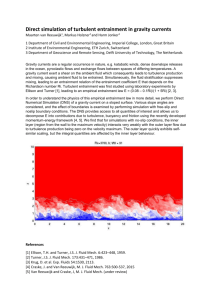
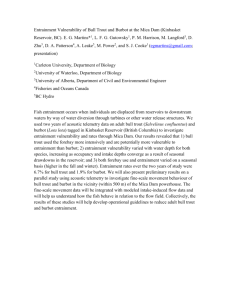
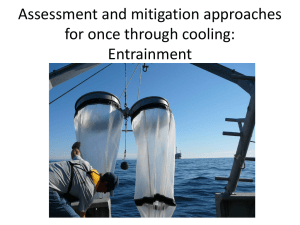
![Powerpoint Slide Set [, 6mb]](http://s2.studylib.net/store/data/005481140_1-14d8ec4dc37c7467f94ebd1212815b7e-300x300.png)
